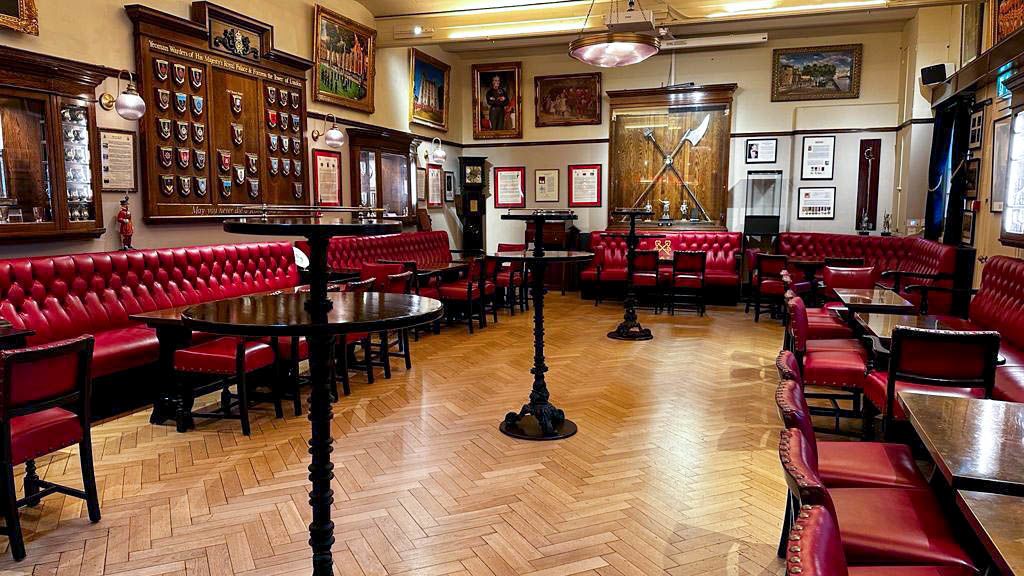The 900-year-old Tower of London is the UK’s most popular historic attraction, with more than 3 million visitors entering its gates to explore its ancient corridors, view the royal Crown Jewels, and encounter its legendary ravens and distinctively attired “Beefeater” Yeoman Warder guards.
But there’s one secret they don’t get to see – London’s most exclusive pub.
At first glance, The Keys looks just like any other much-loved UK pub, with leather banquettes, rectangular wooden tables, and an ornately decorated carpet. But its décor boasts unique regal features, including a 16th century ceremonial ax and cabinets displaying Yeoman Warder uniforms.
The pub is run by the Tower’s 35 serving Yeomen Warders, who get their “Beefeater” nickname from the daily meat ration they were traditionally given. Only they and their invited guests are allowed to enter.
With lodgings for resident Beefeaters and their families, a doctor’s office and a chapel, the Tower can feel like a village for those living there. And like any proud village, the pub is an important part of the community – a place they can go to celebrate special occasions or unwind after a busy day.
From sergeant to gaoler
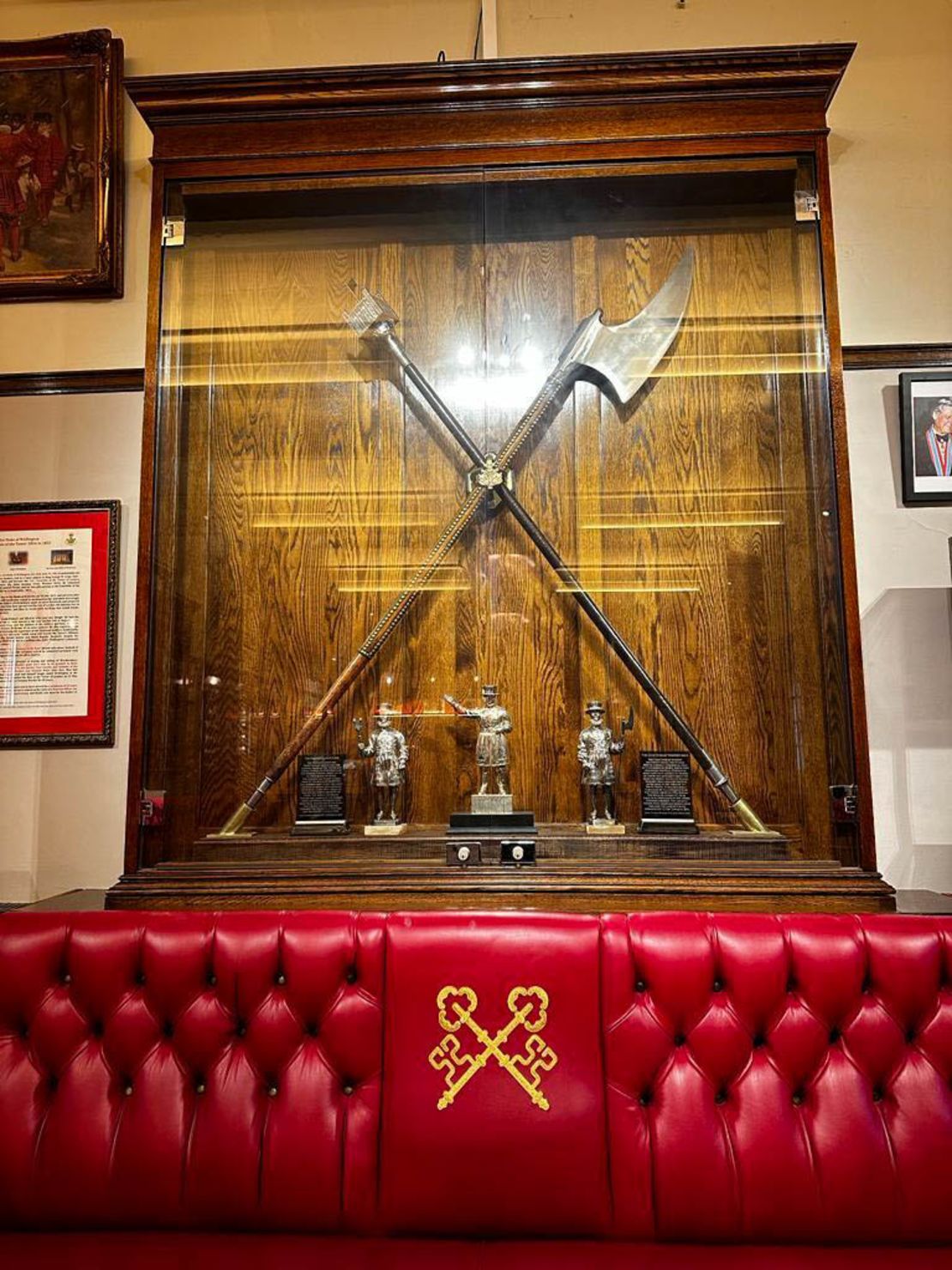
“It’s there as a community hub, but we also use it as a vehicle to raise money for charities by hosting groups of colleagues and friends,” says Robin Fuller, chief of the Yeoman body. “Normally we raise about £500 (about $635), and it’s important to us because we reach out to quite a few of these little-known organizations, and that small amount of money goes an awful long way for them.”
Originally from northwest London, Fuller joined the Yeoman guards in 2011 after serving in the Royal Navy for 34 years. “I sent a speculative CV off to the Tower and luckily, I received a reply,” he says. “After a second interview with the Constable of the Tower… I was selected to become the 393rd Yeoman Warder since 1827.”
Over 13 years, Fuller has climbed the ladder, from Yeoman Warder to sergeant, to gaoler (a historic term for the person in charge of a prison, and second-in-charge of the Yeoman body) and finally to chief.
According to Fuller, a much-loved feature of the pub is the exclusive drinks. Supplied by UK brewery Marston’s, an age-old agreement means the pub is allowed to remarket their drinks with names such as Beefeater Bitter, Treason, and Yeoman 1485, referring to the year Yeoman Warders were founded.
‘May you never die a Yeoman Warder’
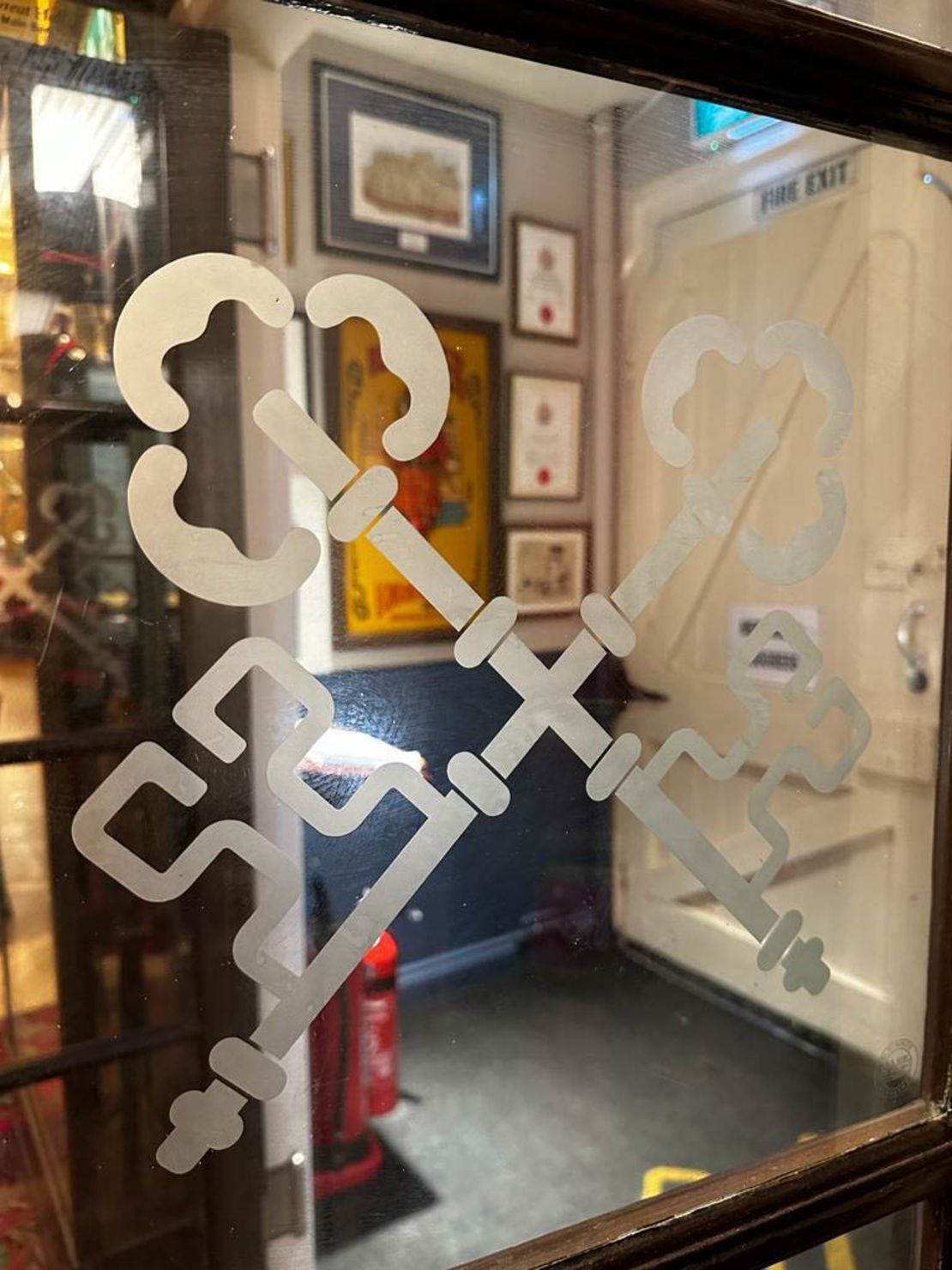
There have been several pubs at the Tower of London over the centuries, and The Keys has inherited many of its predecessors’ ancient traditions.
These include the Yeoman toast: “May you never die a Yeoman Warder.” Historically, guards retiring from the Tower could sell their jobs for about 250 guineas (a guinea was worth slightly more than a pound). But if they died before retirement, the constable would sell the job instead and their families would get nothing.
“We always explain that story when we’re having a dinner,” says Yeoman Gaoler Clive Towell. “And at that point we then boo the constable, toast with our silver goblets and drink our port.”
While the toast is still used, the practice of buying and selling warderships was abolished in 1826 by the Duke of Wellington. Instead, he introduced new requirements for Yeoman Warders – declaring that they all had to be honorable ex-soldiers.
This condition is still maintained today. According to Historic Royal Palaces, an independent charity that looks after some of the UK’s ancient landmarks, new Yeoman Warder candidates must be “a former warrant officer or senior non-commissioned officer having served the minimum 22 years in the Army, Royal Air Force, Royal Marines or Royal Navy and hold the Long Service and Good Conduct medal.”
Yeomanry in the 21st century
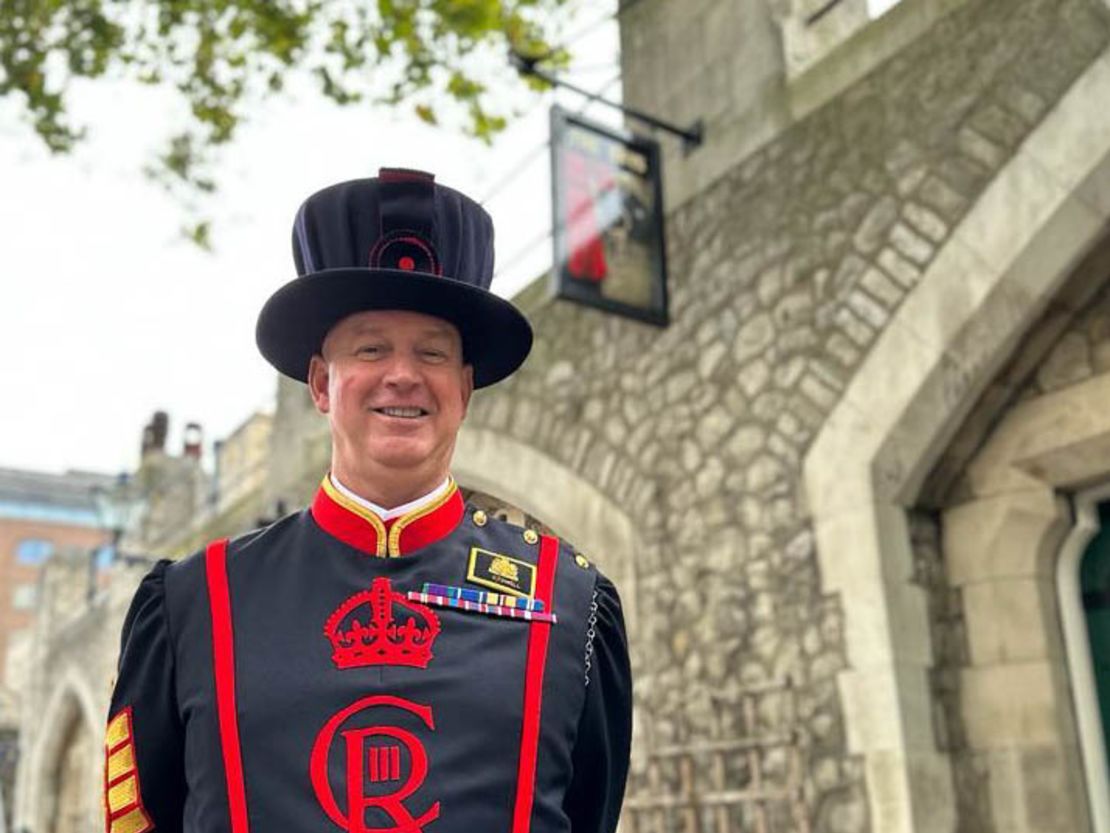
As with any ancient position, over the centuries, the role of a Yeoman Warder – officially known as “Yeoman Warder of His Majesty’s Royal palace and Fortress the Tower of London, and Members of the Sovereign’s Body Guard of the Yeoman Guard Extraordinary’” – has also changed.
Where once they were responsible for guarding the Tower and all things within it, including the Crown Jewels, and supervising prisoners, today’s Yeomen spend much of their time dealing with enthusiastic tourists and having their pictures taken.
“Our modern roles involve welcoming visiting members of the public to the Tower, leading our famous Yeoman Warder tours, and sharing legends and facts from the history of this famous fortress with all who choose to enter,” says Towell.
For Fuller, meeting people from all walks of life is one of his favourite parts of the job. “It’s nice to broaden your horizons,” he says. “Everyone’s got a place in the Tower and if they’re willing enough to come in here and ask some questions, the least we can do is give them their answers and perhaps learn from them as well.”
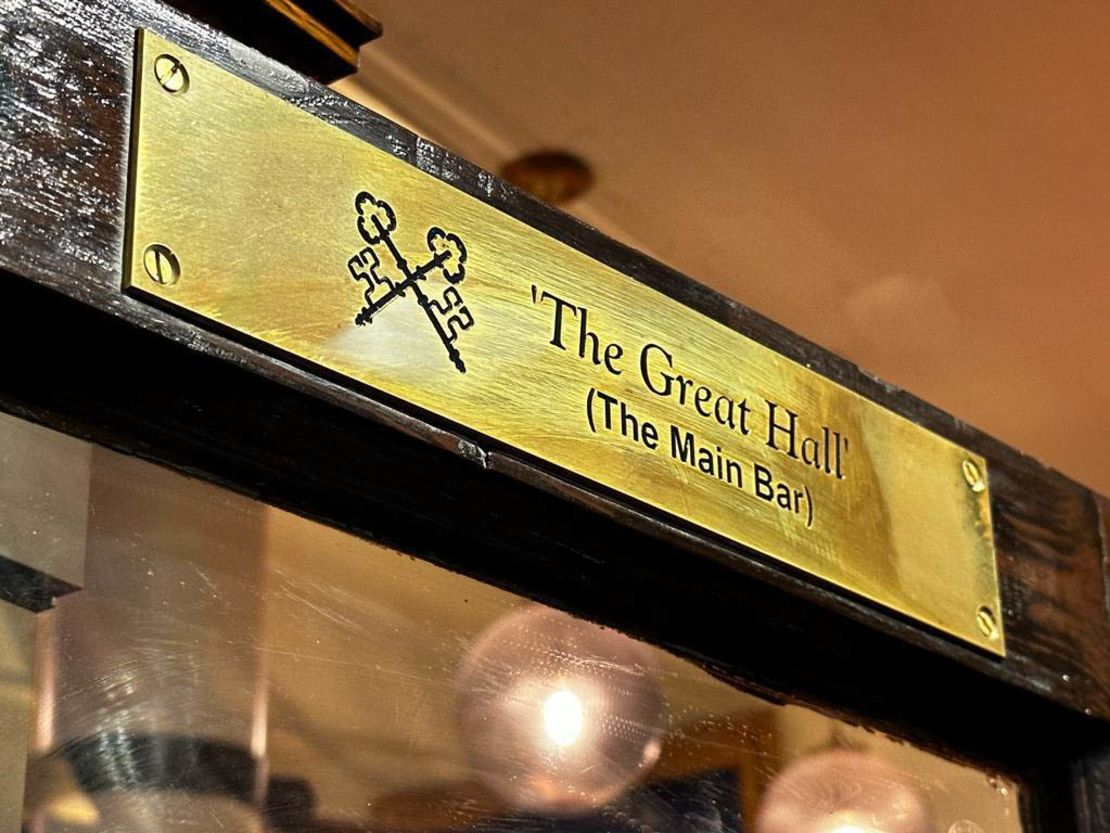
Not all their traditions have been modernized. Yeomen still attend several royal ceremonies including the coronation of the sovereign, London’s annual Lord Mayor’s Show and other state and charity functions.
Historic Tudor customs mandate that on state occasions, Beefeaters must wear their ceremonial uniform, also known as “reds,” consisting of a scarlet and gold tunic with red stockings, a white Tudor ruff and black shoes.
But the uniform that most Tower of London visitors will be familiar with is the “Blue Undress,” which consists of red and dark blue tunic and trousers, worn with a Tudor bonnet and black shoes, as well as the cypher of the current monarch.
“[It] was changed to ‘CIIIR’ just ahead of the Coronation earlier this year after 70 years of ‘EIIR’, for Her Late Majesty Queen Elizabeth II,” explains Fuller.
Curse of the ravens
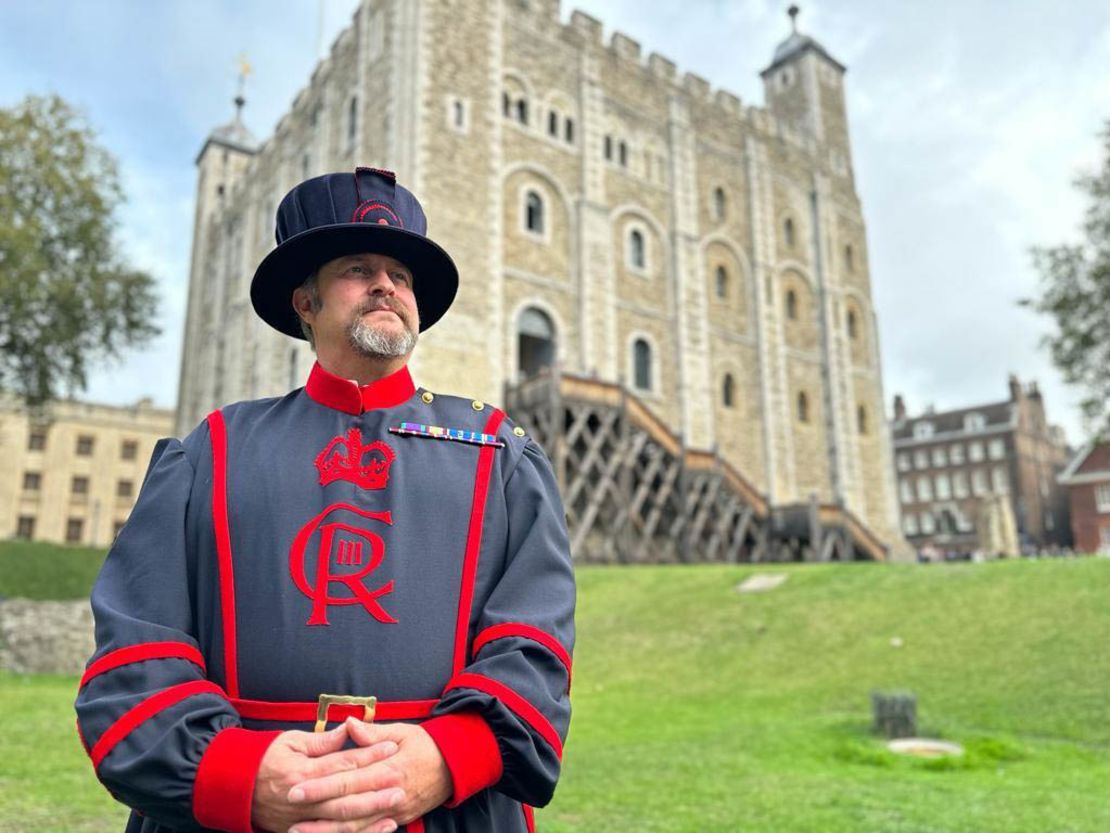
Each night, Fuller also changes into a traditional red watch coat and Tudor bonnet to perform a ritual that inspired the name of the pub: the Ceremony of the Keys.
Enveloped in darkness, at precisely seven minutes to 10 p.m., the ceremony is enacted amid the Tower of London’s battlements, forming part of the traditional “locking up” of the Tower – a practice that has lasted for over 740 years.
“It [the Ceremony of the Keys] is a must, you can’t forget that,” says Fuller. “I’ve got alarms set all over the house to make sure that I’m up, primed and ready. And when I’ve finished the ceremony, I’ll always go up to the pub and have a chat with those who are in there just to make sure everything’s ok.”
Traditional ceremonies aside, centuries-old superstitions also play a large part in how the fortress is maintained today. By royal decree, thought to have started by King Charles II in the 17th century, six ravens are kept within the grounds of the Tower, though currently there are seven, all with names like Poppy, Rex and Georgie.
According to Yeoman Ravenmaster Chris Skaife, the legend goes, “Should the ravens leave the Tower of London, it will crumble to dust and a great harm will befall our kingdom.”
Skaife has been looking after these feathered jewels, known as the guardians of the Tower, for 17 years. His role involves all the usual duties of a Yeoman Warder, as well as extra responsibilities like cleaning the ravens’ cages and feeding them the very best meat that birds can eat, including beef, mice and chicks.
“I never really like to stare at a raven in its eye because it feels to me like they’re looking down into your soul,” he says.
